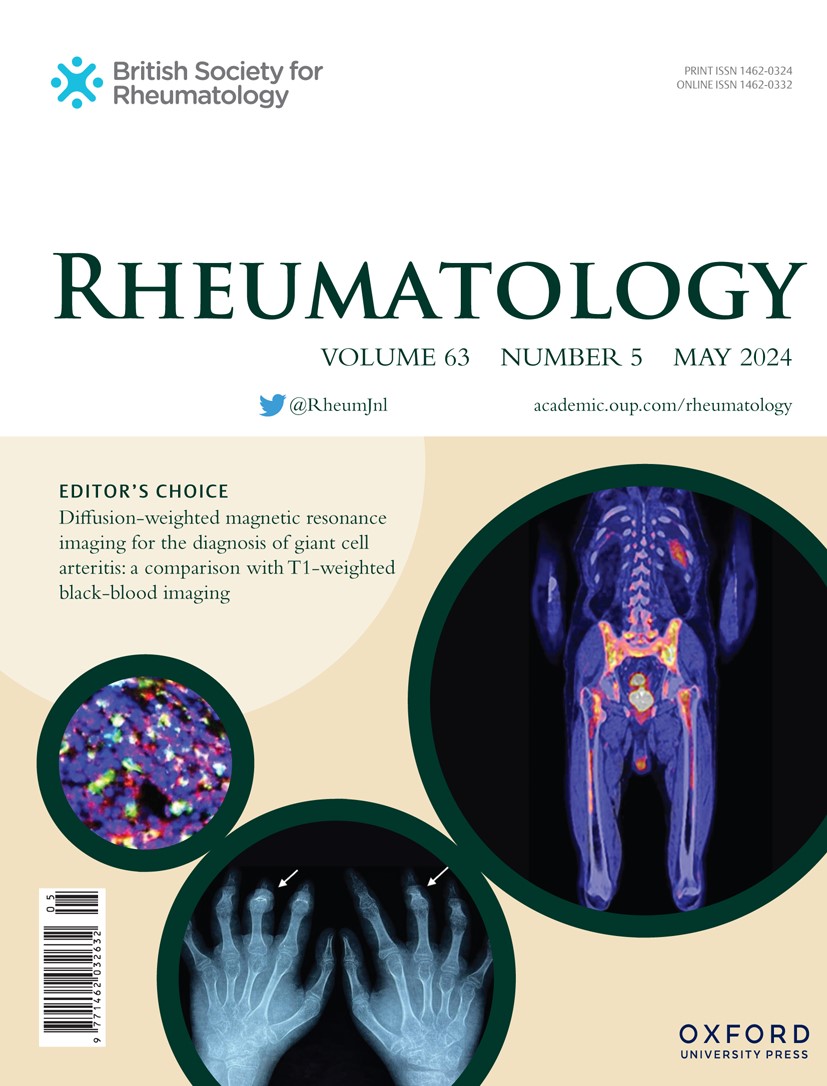E062 Real-world experience of tofacitinib as treatment for juvenile idiopathic arthritis
IF 4.7
2区 医学
Q1 RHEUMATOLOGY
引用次数: 0
Abstract
Background/Aims In October 2021, the National Institute for Health and Care Excellence (NICE) recommended tofacitinib to treat polyarticular juvenile idiopathic arthritis (JIA) and juvenile psoriatic arthritis in cases resistant to at least one DMARD and for whom a TNFα inhibitor is not suitable or does not control disease adequately. This study aimed to assess the effectiveness of tofacitinib in treating resistant JIA, and identify any trends linked to treatment success or failure. Methods The project was registered as an audit and service evaluation. Patients (≤ 18 years with JIA, who received tofacitinib between October 2021 and June 2024 with ≥ 3 months follow-up) were identified by the Paediatric Rheumatology Pharmacist. Data were collected retrospectively from electronic patient records. These included patient demographics, previous and concomitant medications, active joint count and inflammatory markers at baseline and 3-monthly follow-up. Results Seven patients (3 female) were included with a median age at diagnosis of 7 years (range: 1-13 years). Median disease duration before starting tofacitinib was 3.6 years (range: 1.1-13.2 years). The oral route was a factor in choosing tofacitinib in two patients with needle anxiety. Demographic and follow-up data are shown in Table 1. Of 4 patients with active joints at baseline only 2 had a decrease in active joint count by 12 weeks. Three patients with extended oligoarthritis continued tofacitinib successfully, suggesting a possible link between this category and treatment success. However, two of these had no active arthritis a baseline which may be a factor. All patients who stopped tofacitinib did so due to a flare of arthritis rather than side effects. One patient developed new uveitis while on tofacitinib. No association was found between treatment success and gender, ANA status, or previous history of uveitis. Disease duration before starting tofacitinib also appeared to have no effect on outcomes. Conclusion Although the small sample size limits the ability to draw definitive conclusions, some initial trends suggest that tofacitinib is effective in controlling extended oligoarthritis. It appears to be partially effective in psoriatic and RF-negative polyarticular JIA initially but did not achieve complete remission. The side effect profile seems tolerable. Disclosure A. Vahed: None. K. Hartley: None. S. Jandial: None. F. McErlane: None. S. Sampath: None. E.S. Sen: None.托法替尼治疗青少年特发性关节炎的实际经验
背景/目的2021年10月,美国国家卫生与保健卓越研究所(NICE)推荐托法替尼用于治疗对至少一种DMARD耐药且TNFα抑制剂不适合或不能充分控制疾病的多关节幼年特发性关节炎(JIA)和幼年银屑病关节炎。本研究旨在评估托法替尼治疗耐药JIA的有效性,并确定与治疗成功或失败相关的任何趋势。方法将该项目注册为审计和服务评价项目。患者(≤18年JIA,在2021年10月至2024年6月期间接受托法替尼治疗,随访≥3个月)由儿科风湿病药剂师确定。回顾性收集电子病历资料。这些包括患者的人口统计数据、既往和伴随用药、活跃关节计数和基线和3个月随访时的炎症标志物。结果纳入7例患者(3例女性),诊断时中位年龄为7岁(范围1-13岁)。开始托法替尼前的中位疾病持续时间为3.6年(范围:1.1-13.2年)。口服途径是两名患者选择托法替尼针焦虑的一个因素。人口统计和随访数据见表1。在基线时关节活动的4例患者中,只有2例在12周后活动关节计数减少。三名患有延伸性寡关节炎的患者成功地继续使用托法替尼,这表明这一类别与治疗成功之间可能存在联系。然而,其中两人没有活动性关节炎,这可能是一个因素。所有停用托法替尼的患者都是因为关节炎发作而不是副作用。一名患者在使用托法替尼时出现了新的葡萄膜炎。治疗成功与性别、ANA状态或既往葡萄膜炎史没有关联。开始使用托法替尼之前的疾病持续时间似乎也对结果没有影响。结论:虽然样本量小限制了得出明确结论的能力,但一些初步趋势表明托法替尼对控制延展性寡关节炎有效。它最初似乎对银屑病和rf阴性多关节性JIA部分有效,但未达到完全缓解。副作用似乎是可以忍受的。A.瓦赫德:没有。哈特利:没有。詹迪尔:没有。F.麦克莱恩:没有。萨姆帕斯:没有。E.S. Sen:没有。
本文章由计算机程序翻译,如有差异,请以英文原文为准。
求助全文
约1分钟内获得全文
求助全文
来源期刊

Rheumatology
医学-风湿病学
CiteScore
9.40
自引率
7.30%
发文量
1091
审稿时长
2 months
期刊介绍:
Rheumatology strives to support research and discovery by publishing the highest quality original scientific papers with a focus on basic, clinical and translational research. The journal’s subject areas cover a wide range of paediatric and adult rheumatological conditions from an international perspective. It is an official journal of the British Society for Rheumatology, published by Oxford University Press.
Rheumatology publishes original articles, reviews, editorials, guidelines, concise reports, meta-analyses, original case reports, clinical vignettes, letters and matters arising from published material. The journal takes pride in serving the global rheumatology community, with a focus on high societal impact in the form of podcasts, videos and extended social media presence, and utilizing metrics such as Altmetric. Keep up to date by following the journal on Twitter @RheumJnl.
 求助内容:
求助内容: 应助结果提醒方式:
应助结果提醒方式:


